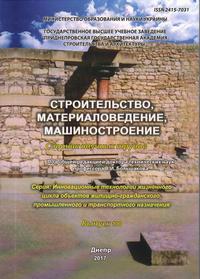Tray investigation of tangential stress along the pile, which isn’t previously connected with a fragment of raft
Keywords:
flume research, gradual loading of the pile foundation fragment, additional tangential stresses, soil deformation.Abstract
Annotation. Purpose. Laboratory research of the stress-strain state of base fragment of pile foundation with individual, or sequential loading of its elements, to obtain a qualitative picture of the process’ influence of the alternate involvement the pile foundations’ elements to work on the forces’ behavior of additional tangential stress and friction along the lateral surface of the pile. Methodology. Two series of tests were carried out: first series - the plate connected with the pile was loaded (it imitates the work of the classical pile foundation fragment, which deformation of the base will be taken as 100%). During the 2nd and 3rd series, the elements of the pile foundation fragment were gradually applied to the work (loaded plate, not connected with the pile, and subsequently the plate and the pile were interconnected), but during the third series, additionally, the pile was loaded in the absence of the connection to the stove. Results. During the 1-st stage of the second and third series of tests deformation of the soil under the plate, that caused the displacement of the pile (unconnected with the piece of plate), was recorded. Originality. Laboratory recorded the occurrence of additional tangential stresses around the pile, unconnected with the piece of plate under loading plate, to the depth of 1,2...1,8 of the width of the piece of plate. Practical value. The model of the pile foundations’ fragment, the elements of which are involved to the work of the rotate, is capable of perceiving and withstand greater loads in comparison with the simultaneous loading of the piles’ foundation’s fragment. Sequential mobilization of all components of the pile foundation will help increase their trust level and to utilize the maximum potential of the ground bases, which could be an additional factor in the preservation of resources for the construction of pile foundations in general.
References
Baholdin B. V. Issledovanie napryazhenno-deformiruemogo sostoyaniya svai i okolosvajnogo grunta pri ego osadke / B.V. Baholdin, V. I. Berman // Trudy instituta. Vypusk 65 : Svajnye fundamenty / nauch. red. B. V. Baholdin ; Nauch.-issled. in-t osnovanij i podzemnyh sooruzhenij Gosstroya SSSR. - Moskva, 1975. - S. 35-44.
Bojko І. P. Doslіdzhennya pererozpodіlu zusil' u fundamentі pri rіznih varіantah roztashuvannya pal' / І. P. Bojko, V. L. Pіdluc'kij // Osnovi і fundamenti : mіzhvіdom. nauk.-tehn. zb. / Kiїv. nac. un-t bud-va і arhіt. - Kiїv, 2015. Vip. 37. - S. 64-73.
Sєdіn V. L. Lotkovі doslіdzhennya napruzheno-deformovanogo stanu osnovi pal'ovogo fundamentu pri poetapnomu navantazhennі jogo elementіv / Sєdіn V. L., Bіkus K. M., Kovba V. V. // Stroitel'stvo, materialovedenie, mashinostroenie : sb. nauch. tr. Seriya: «Starodubovskie chteniya 2017» / GVUZ «Pridnepr. gos. akad. str-va i arhitektury» ; pod. obschej redakciej V. I. Bol'shakova. - Dnipro, 2017. - Vyp. 96. - S. 145-150
Solomin V. I. Adaptivnoe upravlenie parametrami gruntov i fundamentov pri vozvedenii sooruzhenij / Solomin V. I., Lushnikov V. V., Orzhehovskij Yu. R. // Sb. trudov SPbGASU. - Sankt-Peterburg, 2012. - S. 337-342.
Brandl H. Cyclic preloading of piles to minimize (differential) settlements of high-rise buildings / H. Brandl // Slovak, 2005. - Slovak University of Technology, 2006. - P. 1-12.
Bjerrum L, Johannessen I. Eide O. Reduction of negative skin friction on steel piles to rock, "Proc. 7th Int. Conf. on Soil Mech. vol. 2, 1969.
Bozozuk M. Bearing capacity of pile preloaded by downdrag, Proc. of the Tenth International Conference on Soil Mechanics and Foundation Engineering, Stockholm 15-19 June 1981
Fellenius, B. H. (1984). Negative skin friction and settlement of piles. Second International Seminar, Pile Foundations, Nanyang Technological Institute, Singapore, November.
Fellenius B., Broms B, Negative skin friction acting on steel pipe pile in clay. Proc. 7th Int. Conf. on Soil Mech. vol.2, 1969.
Poulos H.G. Piled Raft Foundations for Tall Buildings/ Poulos H.G.,Small J.C., Chow H. // Geotechnical Engineering Journal of the SEAGS & AGSSEA, 42, No.2, 2011. - RR. 78-84.
Poulos, H.G. and K.F. Chan, 1986. Laboratory study of pile skin friction in calcareous sand. Proc. GeoTech. Eng., 17 (2): 235-257.
Tan Y.C. Design of Piled Raft Foundation on Soft Ground. / Tan Y.C., Chow, C.M. // GSM-IEM Forum: The roles of Engineering geology & geotechnical engineering in construction works, 2004. - RR. 1-20.
Downloads
Published
Issue
Section
License
Редакція Видання категорично засуджує прояви плагіату в статтях та вживає всіх можливих заходів для його недопущення. Плагіат розглядається як форма порушення авторських прав і наукової етики.
При виявлені у статті більш ніж 25% запозиченого тексту без відповідних посилань та використання лапок, стаття кваліфікується як така, що містить плагіат. У цьому випадку стаття більше не розглядається редакцією, а автор отримує перше попередження.
Автори, в статтях яких повторно виявлено плагіат, не зможуть публікуватися в усіх журналах Видавництва ДВНЗ «Придніпровська державна академія будівництва та архітектури».
Автори, які публікуються у цьому журналі, погоджуються з наступними умовами:
- Автори залишають за собою право на авторство своєї роботи та передають журналу право першої публікації цієї роботи на умовах ліцензії Creative Commons Attribution License, котра дозволяє іншим особам вільно розповсюджувати опубліковану роботу з обов'язковим посиланням на авторів оригінальної роботи та першу публікацію роботи у цьому журналі.
- Автори мають право укладати самостійні додаткові угоди щодо неексклюзивного розповсюдження роботи у тому вигляді, в якому вона була опублікована цим журналом (наприклад, розміщувати роботу в електронному сховищі установи або публікувати у складі монографії), за умови збереження посилання на першу публікацію роботи у цьому журналі.
- Політика журналу дозволяє і заохочує розміщення авторами в мережі Інтернет (наприклад, у сховищах установ або на особистих веб-сайтах) рукопису роботи, як до подання цього рукопису до редакції, так і під час його редакційного опрацювання, оскільки це сприяє виникненню продуктивної наукової дискусії та позитивно позначається на оперативності та динаміці цитування опублікованої роботи (див. The Effect of Open Access).

